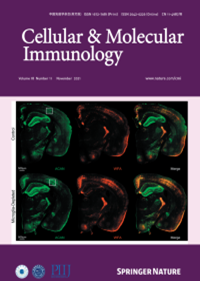肺免疫调节单位的性别二态性印记偏倚性肺纤维化。
IF 19.8
1区 医学
Q1 IMMUNOLOGY
引用次数: 0
摘要
肺纤维化(PF)是两性二态的,男性患病率和严重程度相对较高;然而,其机制尚不清楚。我们的研究发现肺免疫细胞基因存在明显的性别二态性,其中grancalcin (GCA)表现出深刻的性别差异。GCA是由肺部炎症加剧引发的肺浸润骨髓巨噬细胞产生的。然而,在女性肺中富集的独特的HTR2C+肺泡巨噬细胞群对骨髓来源的巨噬细胞进行了代谢重编程,并限制了局部GCA扩增。GCA作为一种新型趋化因子,在Th17细胞中与蛋白酪氨酸磷酸酶受体T型(PTPRT)结合,通过激活ROCK1-MLC通路,促进致病性肺浸润,加重肺纤维化。值得注意的是,GCA和Th17细胞在男性PF患者的肺活检中大量积累,而在女性患者中则没有。与单用吡非尼酮相比,gca中和抗体联合吡非尼酮(一种治疗纤维化的处方药)治疗PF的疗效和生存率更高。总的来说,我们的研究结果表明,性别偏倚的肺纤维化是由肺免疫调节单位形成的,这可能是限制肺纤维化的目标。本文章由计算机程序翻译,如有差异,请以英文原文为准。

Sexual dimorphism of lung immune-regulatory units imprint biased pulmonary fibrosis
Pulmonary fibrosis (PF) is sexually dimorphic, with a relatively high prevalence and severity in males; however, the mechanism remains unclear. Our study revealed pronounced sexual dimorphism of immune cell genes in the lung, among which grancalcin (GCA) showed profound sex differences. GCA was produced by lung-infiltrating bone marrow macrophages triggered by heightened inflammation in the lung. However, a unique HTR2C+ alveolar macrophage population enriched in female lungs metabolically reprogramed bone marrow-derived macrophages and constrained local GCA amplification. As a novel chemokine, GCA bound to protein tyrosine phosphatase receptor type T (PTPRT) in Th17 cells and facilitated pathogenic lung infiltration by activating the ROCK1-MLC pathway, thus aggravating lung fibrosis. Notably, both GCA and Th17 cells abundantly accumulated in lung biopsies from male PF patients but not in those from female patients. GCA-neutralizing antibodies in combination with pirfenidone, a prescribed medication for treating fibrosis, provided superior effectiveness and survival rates against PF compared with treatment with pirfenidone alone. Overall, our findings reveal that sex-biased lung fibrosis is shaped by lung immune-regulatory units, which could be targeted to limit lung fibrosis.
求助全文
通过发布文献求助,成功后即可免费获取论文全文。
去求助
来源期刊
CiteScore
31.20
自引率
1.20%
发文量
903
审稿时长
1 months
期刊介绍:
Cellular & Molecular Immunology, a monthly journal from the Chinese Society of Immunology and the University of Science and Technology of China, serves as a comprehensive platform covering both basic immunology research and clinical applications. The journal publishes a variety of article types, including Articles, Review Articles, Mini Reviews, and Short Communications, focusing on diverse aspects of cellular and molecular immunology.

 求助内容:
求助内容: 应助结果提醒方式:
应助结果提醒方式:


